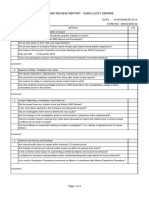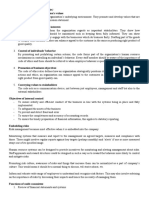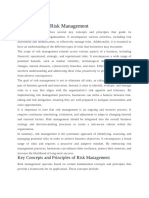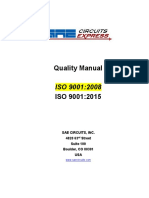Chapter 5
Chapter 5
Uploaded by
syrexdestroyerCopyright:
Available Formats
Chapter 5
Chapter 5
Uploaded by
syrexdestroyerOriginal Title
Copyright
Available Formats
Share this document
Did you find this document useful?
Is this content inappropriate?
Copyright:
Available Formats
Chapter 5
Chapter 5
Uploaded by
syrexdestroyerCopyright:
Available Formats
1.
Risk Management in Governance:
Definition: Risk management in governance refers to the systematic process of
identifying, assessing, prioritizing, and mitigating risks that could affect an
organization's ability to achieve its objectives, while ensuring that decision-making
processes align with the organization's mission, values, and stakeholder interests.
Key Components of Risk Management in Governance:
1. Risk Identification:
The first step in risk management involves identifying potential risks that an
organization may face. These risks can be categorized into various types, including
strategic, operational, financial, and compliance risks. This phase requires organizations
to systematically identify and document potential risks that could affect their objectives.
It's essential to have a clear understanding of both internal and external risks, such as
market fluctuations, cybersecurity threats, operational challenges, or supply chain
disruptions. In today's digital age, technology plays a crucial role in risk management.
Organizations leverage data analytics, artificial intelligence, and predictive modeling to
identify emerging risks, analyze large datasets, and enhance risk forecasting.
Additionally, cybersecurity tools are essential for protecting against cyber threats, which
have become a significant risk for most organizations.
2. Risk Assessment:
Once risks are identified, they must be assessed in terms of their potential
impact and likelihood of occurrence. This helps in prioritizing risks and allocating
resources for mitigation. After identifying risks, organizations need to assess them in
terms of their potential impact and likelihood of occurrence. Risk assessments often use
quantitative and qualitative methods to prioritize risks. For example, a risk matrix can
help visualize and categorize risks based on severity and probability.
3. Risk Mitigation:
After prioritizing risks, strategies for risk mitigation are developed. These
strategies may include risk avoidance, risk transfer, risk reduction, or risk acceptance.
Once risks are assessed, organizations develop strategies for risk mitigation. These
strategies vary depending on the nature of the risk. Risk avoidance may involve exiting
high-risk markets or discontinuing risky product lines. Risk reduction could involve
improving cybersecurity measures or diversifying suppliers. Risk transfer might include
purchasing insurance.
4. Monitoring and Control:
Risk management is an ongoing process. Continuous monitoring of risks is
essential to identify changes in the risk landscape and to ensure that mitigation
measures remain effective. Organizations must continuously monitor identified risks and
control measures. This includes tracking key risk indicators and adjusting mitigation
strategies as circumstances change.
5. Integration with Governance:
Effective risk management should be integrated into an organization's governance
structure. This means that risk considerations should inform decision-making processes
at all levels of the organization. This integration ensures that risk considerations are
part of decision-making at all levels. Key aspects of this integration include:
Risk Governance Committees: Establishing committees or boards responsible for
overseeing risk management and ensuring that it aligns with the organization's
strategic goals.
Risk Culture: Promoting a risk-aware culture where employees are encouraged to
identify and report risks, fostering an environment where risk management is
everyone's responsibility.
Importance of Risk Management in Governance:
-Protection of Stakeholder Interests:
Proper risk management helps protect the interests of stakeholders, including
shareholders, customers, employees, and the broader community.
- Compliance:
It ensures that an organization complies with relevant laws and regulations,
reducing legal and regulatory risks.
- Enhanced Decision-Making:
Risk management provides decision-makers with valuable information, allowing
them to make informed choices that align with the organization's goals.
- Long-Term Sustainability:
Effective risk management contributes to the long-term sustainability and
resilience of the organization.
2. Regulatory Compliance:
Definition: Regulatory compliance refers to the process by which organizations adhere
to relevant laws, regulations, and industry standards that govern their operations. It
involves a proactive approach to ensure that an organization operates within legal
boundaries.
Compliance Framework
To effectively navigate the complex landscape of regulations, organizations often
implement a compliance framework, which includes the following elements:
Regulatory Mapping: Identifying and categorizing all applicable laws, regulations, and
industry standards relevant to the organization's operations.
Policy Development: Creating policies and procedures that guide employees in adhering
to compliance requirements. These policies should be clear, accessible, and regularly
updated.
Training and Education: Conducting regular training and awareness programs to ensure
that employees understand and comply with regulations. This includes specific training
on ethics and conduct.
Auditing and Monitoring: Conducting internal audits and assessments to identify
compliance gaps and implementing corrective actions. This may also involve conducting
third-party audits.
Whistleblower Programs: Establishing mechanisms for employees and stakeholders to
report suspected violations anonymously, creating a culture of accountability.
Cross-Border Compliance: In an increasingly globalized world, organizations often face
the challenge of complying with regulations across different jurisdictions. This requires a
deep understanding of international laws, trade agreements, and data privacy
regulations. For example, the General Data Protection Regulation (GDPR) in Europe has
far-reaching implications for organizations handling European citizens' data, regardless
of where the organization is based.
Key Aspects of Regulatory Compliance:
1. Understanding Regulations: Organizations must have a deep understanding of the
regulations that apply to their industry and operations. This involves continuous
monitoring of regulatory changes.
2. Policies and Procedures: Developing and implementing policies and procedures that
ensure compliance with applicable regulations.
3. Training and Education: Ensuring that employees are aware of and trained on
compliance requirements.
4. Monitoring and Reporting: Regularly monitoring compliance, reporting violations or
potential issues, and taking corrective action when necessary.
5. Documentation: Maintaining comprehensive records of compliance activities,
including audits, assessments, and training.
Importance of Regulatory Compliance:
- Legal Protection: Compliance helps protect organizations from legal action, fines, and
reputational damage resulting from non-compliance.
- Reputation Management: Compliant organizations are often viewed more favorably by
customers, investors, and the public.
- Risk Mitigation: Compliance efforts can identify and address risks associated with
regulatory violations.
- Operational Efficiency: Streamlined processes and clear guidelines can lead to
improved operational efficiency.
3. Audit and Assurance in Governance:
Definition: Audit and assurance in governance is the process of independently
examining and evaluating an organization's financial and operational processes,
controls, and reporting to provide assurance to stakeholders that the organization's
operations are conducted effectively, efficiently, and in compliance with applicable laws
and regulations.
Key Aspects of Audit and Assurance in Governance:
1. Internal vs. External Auditing: Internal audits are conducted by an organization's
internal audit team to assess internal controls and processes. External audits are
typically conducted by independent audit firms to provide an objective evaluation to
external stakeholders.
2. Financial Audits: These audits focus on the accuracy and completeness of financial
statements, ensuring compliance with accounting standards.
3. Operational Audits: These audits assess the efficiency and effectiveness of an
organization's operations, including processes and controls.
4. Compliance Audits: Ensuring that an organization complies with relevant laws and
regulations.
5. Reporting: Providing clear and transparent reports of audit findings to stakeholders.
Importance of Audit and Assurance in Governance:
- Transparency: Audits provide transparency to stakeholders, including shareholders,
regulators, and the public, regarding an organization's financial health and operational
effectiveness.
- Risk Identification: Audits can identify weaknesses in internal controls and processes,
allowing organizations to mitigate risks.
- Trust and Credibility: External audits enhance trust and credibility, especially in the
case of financial reporting.
- Accountability: Audits hold organizations accountable for their actions and decisions.
In conclusion, risk management, regulatory compliance, and audit and assurance are
integral components of governance that help organizations operate ethically, efficiently,
and in the best interests of their stakeholders. These practices contribute to an
organization's long-term success and sustainability.
You might also like
- The GRC ProfessionalDocument13 pagesThe GRC ProfessionalAlizaShaikhNo ratings yet
- RMA2Document5 pagesRMA2Shagun Pathania100% (3)
- Master Sms RewiewDocument3 pagesMaster Sms RewiewIhwan Asrul100% (1)
- Strategic ControlDocument6 pagesStrategic ControlTedtenor100% (1)
- Financial ControllershipDocument27 pagesFinancial Controllershipmarife75% (4)
- Check List Iso 17065 2012Document35 pagesCheck List Iso 17065 2012Wahyuningsih JacobNo ratings yet
- Component of ERMDocument8 pagesComponent of ERMSaritaBhusalNo ratings yet
- CatDocument4 pagesCatdigitisationpartnerNo ratings yet
- ISO 31000 Risk Management Process: Osama Mohammed Quality & Safety OfficerDocument25 pagesISO 31000 Risk Management Process: Osama Mohammed Quality & Safety Officerwajdi azouziNo ratings yet
- Risk ManagementDocument10 pagesRisk Managementreneesh vNo ratings yet
- Finance Credit & Risk ManagementDocument16 pagesFinance Credit & Risk Managementfatima siddiquiNo ratings yet
- SormDocument4 pagesSormsindhungadelaNo ratings yet
- Risk Audit Ensuring OrganizationalDocument2 pagesRisk Audit Ensuring Organizationalmatas.jaazielNo ratings yet
- Credit Risk Essay QuestionDocument8 pagesCredit Risk Essay QuestionMenna AghanyNo ratings yet
- Stakeholders Lecture 3-1Document50 pagesStakeholders Lecture 3-1almaaruffuraha26No ratings yet
- Compliance DefinitionDocument3 pagesCompliance Definitionanamika2023100% (2)
- Risk EvaluationDocument4 pagesRisk EvaluationMd Fazle RabbiNo ratings yet
- Corporate GovernanceDocument37 pagesCorporate GovernanceTool RoolNo ratings yet
- InfoAssuranceAssign3 (sp21 BCT 028)Document6 pagesInfoAssuranceAssign3 (sp21 BCT 028)Yasir ArfatNo ratings yet
- Compliance Management Report 1Document3 pagesCompliance Management Report 1Lhin John MaglasangNo ratings yet
- UNIT 3-1Document13 pagesUNIT 3-1Aditya IngaleNo ratings yet
- RM-m10Document5 pagesRM-m10Angel Ann GudgadNo ratings yet
- Last DayDocument2 pagesLast DaydominicNo ratings yet
- Module 5 Internal ControlDocument3 pagesModule 5 Internal ControlMar JinitaNo ratings yet
- Internal Control and Fraud Risk FactorsDocument31 pagesInternal Control and Fraud Risk Factorsmax pNo ratings yet
- 1 - Internal Control PPDocument19 pages1 - Internal Control PPAliah MagumparaNo ratings yet
- ERM - COSO Application TechniquesDocument113 pagesERM - COSO Application TechniquesAndika Buzz100% (5)
- Tài Liệu Chưa Có Tiêu ĐềDocument4 pagesTài Liệu Chưa Có Tiêu ĐềBui Thu HoaiNo ratings yet
- Understanding Risk ManagementDocument5 pagesUnderstanding Risk ManagementKhawaja AnasNo ratings yet
- Risk MGT CWDocument20 pagesRisk MGT CWJovy IvyNo ratings yet
- Lecture3 - Internal Control SystemDocument24 pagesLecture3 - Internal Control SystemUmar KhanNo ratings yet
- Source and Evaluation of Risks: Learning OutcomesDocument34 pagesSource and Evaluation of Risks: Learning OutcomesNATURE123No ratings yet
- What Are Internal ControlsDocument2 pagesWhat Are Internal Controlsms1676514No ratings yet
- Event AnalysisDocument8 pagesEvent AnalysisCharles Kamizhi CholaNo ratings yet
- Identification and Analysis of Risk ManagementDocument16 pagesIdentification and Analysis of Risk ManagementABIODUN MicahNo ratings yet
- Notes For SCRDocument3 pagesNotes For SCRlitee1983No ratings yet
- CG EssayDocument10 pagesCG EssayDeepak ChaudharyNo ratings yet
- Risk ManagementDocument36 pagesRisk ManagementDaniel KiptooNo ratings yet
- Risk Management 1Document3 pagesRisk Management 1astraiaNo ratings yet
- Assig 2Document29 pagesAssig 2vinayNo ratings yet
- Chapter 2 Source and Evaluation of Risks Annotated NotesDocument34 pagesChapter 2 Source and Evaluation of Risks Annotated NotesRoshan PednekarNo ratings yet
- Risk ManagementDocument29 pagesRisk Managementeon.hasan.1No ratings yet
- Internal Control & Inv MGMTDocument25 pagesInternal Control & Inv MGMTSushil Shrestha100% (1)
- Another Assignment No. 1Document15 pagesAnother Assignment No. 1Vineet KumarNo ratings yet
- Risk ManagementDocument27 pagesRisk Managementbabedikhumo065No ratings yet
- THIÊN LONGDocument27 pagesTHIÊN LONGnhomhocquizletNo ratings yet
- Risk Management and InsuranceDocument22 pagesRisk Management and Insurancetarun100% (1)
- Module 5 - Control FrameworkDocument34 pagesModule 5 - Control FrameworkAvaNo ratings yet
- hiliDocument3 pageshilidodoformalNo ratings yet
- Sara - Unit-3Document33 pagesSara - Unit-3kaganesh.cyberNo ratings yet
- Bản Sao Của Compliance AuditDocument11 pagesBản Sao Của Compliance Auditqgminh7114No ratings yet
- Unit 123Document22 pagesUnit 123Khushal GargNo ratings yet
- Sia 2Document1 pageSia 2Yana Pandu PrawiraNo ratings yet
- ECON NotesDocument5 pagesECON NotesLaniza Jane PedragordaNo ratings yet
- BSBRSK301Document35 pagesBSBRSK301Vineet Kumar100% (1)
- Bhanu BEDocument4 pagesBhanu BEkinshukNo ratings yet
- 310 C G Imp Karan KanadeDocument67 pages310 C G Imp Karan KanadeMonika NehereNo ratings yet
- MGT209- MODULE 1Document3 pagesMGT209- MODULE 1Renella Mary MapaNo ratings yet
- Mastering Internal Audit Fundamentals A Step-by-Step ApproachFrom EverandMastering Internal Audit Fundamentals A Step-by-Step ApproachRating: 4 out of 5 stars4/5 (1)
- Hardening by Auditing: A Handbook for Measurably and Immediately Iimrpving the Security Management of Any OrganizationFrom EverandHardening by Auditing: A Handbook for Measurably and Immediately Iimrpving the Security Management of Any OrganizationNo ratings yet
- Sop Audit ProcessDocument14 pagesSop Audit Processmanis26No ratings yet
- Control System ComponentsDocument4 pagesControl System ComponentsDAVID SANDIMBANo ratings yet
- Acceptance Criteria For Inspections and Inspection Agencies (AC304)Document4 pagesAcceptance Criteria For Inspections and Inspection Agencies (AC304)Sathiaram Ram100% (1)
- Internal Audit QaqcDocument3 pagesInternal Audit QaqcMurali Krishna DNo ratings yet
- Quality, Health, Safety and EnvironmentDocument27 pagesQuality, Health, Safety and Environmentemeka2012No ratings yet
- Supplier Evaluation ProcessDocument14 pagesSupplier Evaluation ProcessvishalNo ratings yet
- True / False QuestionsDocument25 pagesTrue / False QuestionsFalak EnayatNo ratings yet
- Are You Familiar With The Different Types of Audits That Are Commonly Performed in The IT IndustryDocument41 pagesAre You Familiar With The Different Types of Audits That Are Commonly Performed in The IT IndustryandrewjoriiNo ratings yet
- 2018 Annual ReportDocument83 pages2018 Annual ReportZubair MemonNo ratings yet
- Financial ControllershipDocument13 pagesFinancial ControllershipGenessa BasiliscoNo ratings yet
- 05 - ACC653 Questions WK1Document3 pages05 - ACC653 Questions WK1Camilo ToroNo ratings yet
- Internal Audit ProcedureDocument6 pagesInternal Audit ProcedureUsaid KhanNo ratings yet
- Auditing Block 2 3 4 5 6 QUIZZESDocument126 pagesAuditing Block 2 3 4 5 6 QUIZZESEmmanuel PenullarNo ratings yet
- Chapter 4 Audit Evidence: Learning ObjectivesDocument20 pagesChapter 4 Audit Evidence: Learning ObjectivesNik Nur Azmina AzharNo ratings yet
- RIS-3751-TOM Iss 1Document21 pagesRIS-3751-TOM Iss 1RoakhNo ratings yet
- White Paper Combined AssuranceDocument11 pagesWhite Paper Combined Assurancewdr80No ratings yet
- Auditing TheoryDocument88 pagesAuditing TheoryCristineJoyceMalubayIINo ratings yet
- Quality-Manual-080118 (Reference)Document16 pagesQuality-Manual-080118 (Reference)TeoxNo ratings yet
- Auditing SAP R3 - Control Risk AssessmentDocument28 pagesAuditing SAP R3 - Control Risk AssessmentDarleza ZefriNo ratings yet
- Chapter 3 Systems Security and Internal ControlsDocument20 pagesChapter 3 Systems Security and Internal ControlsKEL ASMRNo ratings yet
- Auditing and Assurance Notes 1Document237 pagesAuditing and Assurance Notes 1Sam Mac'ObonyoNo ratings yet
- Annual Due Diligence Questionnaire - SwireDocument7 pagesAnnual Due Diligence Questionnaire - SwireKhanh Tran ManNo ratings yet
- Wbsedcl RtiDocument14 pagesWbsedcl RtikabuldasNo ratings yet
- Auditing Paper May 2019 Old SyllabusDocument7 pagesAuditing Paper May 2019 Old SyllabusKumar SwamyNo ratings yet
- Aud Flash CardsDocument3,014 pagesAud Flash Cardsmohit2uc100% (1)
- Creating An Effective Whistleblowing Environment PDFDocument7 pagesCreating An Effective Whistleblowing Environment PDFglezperaltaNo ratings yet
- CS 4 Identifying NC - 2021 VILTDocument3 pagesCS 4 Identifying NC - 2021 VILTDeepak AroraNo ratings yet
- Management Response To IAIG 2009 Activity ReportDocument7 pagesManagement Response To IAIG 2009 Activity ReportDaniela KabiljoNo ratings yet

























































































